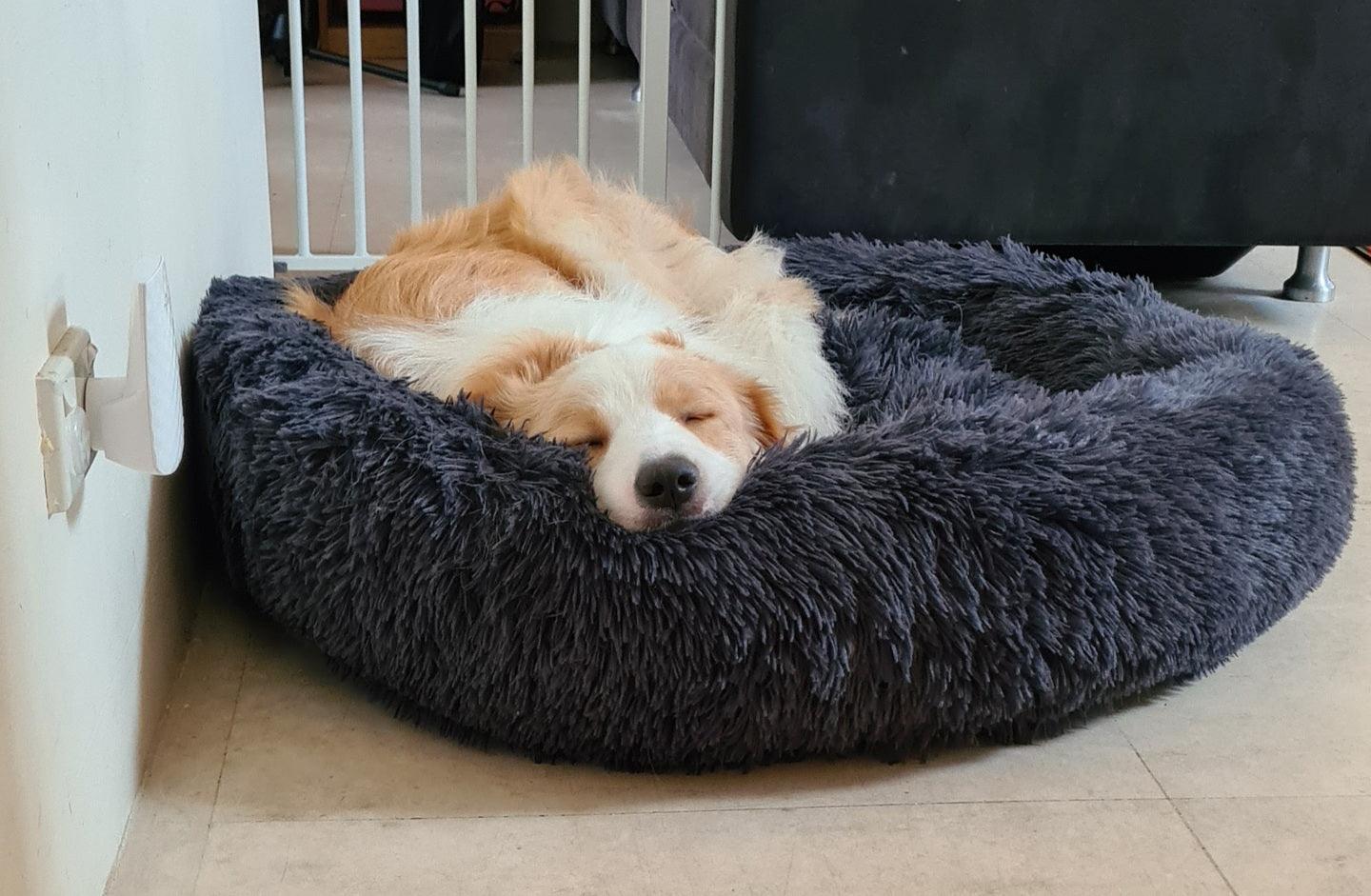Calming dog beds have become quite popular, especially among pet parents whose pups are prone to anxiety. Yet, as with many products that suddenly become widespread, you might have your doubts about the practicality of these beds.

It’s only natural to be sceptical and inquisitive, particularly when your dog’s well-being is at stake. The last thing you want is to get side-tracked with a product that costs more than it’s worth. Fortunately, the research, in this case, seems pretty conclusive. And the good news is that, by all accounts, calming dog beds produce the desired results.
Now all that’s left is to see how these beds work. Let’s dive deeper into the subject, starting with potential reasons why your four-legged friend may be anxious in the first place.
How to Notice Anxiety in Dogs
Dog anxiety may occur from time to time much as it does in humans. But, if this unpleasant emotion persists, it can lead to an actual disorder, resulting in behavioural issues. That’s why it’s important to recognise anxiety symptoms early on.
Dogs can react to anxiety differently, which means not all owners will know what’s happening right away. Symptoms can be more pronounced, including the pup doing their “business” indoors, behaving aggressively or destructively, being restless, or acting depressive.
However, some dogs may show signs of anxiety only by panting, barking too much, or drooling. These symptoms are easy to mistake for regular behaviour. The best way to determine whether something is an anxiety symptom or not is by closely observing your pup.
Determine whether your dog does something unusual occasionally. If so, figure out if the behaviour happens under particular circumstances. For instance, do they urinate in the house when you’re not there or cause damage to doorways, windows, or similar areas? If yes, the pup most likely suffers from separation anxiety.
Of course, aggression will be the most problematic symptom, since the dog will display it towards other dogs or even people. Worse yet, the aggression may be expressed indirectly. For instance, suppose another dog triggers aggression in your pup and you stand between them. In that case, your dog may continue to act aggressively towards you.
After you’ve determined whether the pup is anxious, it will be time to start treating the condition. The key matter here will be to understand the reason behind the anxiety.

Why Is Your Pup Anxious?
We can single out several common reasons for dog anxiety:
- Separation anxiety
- Response to emotions
- A change in environment
- Situational anxiety
- Physical discomfort
- Old age
- The weather
- Fear
Separation anxiety may be the most widespread cause of anxious behaviour. Its main symptoms are howling or barking without end until you return – your neighbours will probably inform you of that. The dog may also destroy furniture and other objects when you’re not around. And if separation anxiety gets particularly severe, they’ll exhibit the same behaviour when you merely step out of the room.
Next, dogs are extremely sensitive to emotions, both those directed toward them and expressed toward another person. For example, frequent arguments between people can make the pup anxious. Any strong emotional display – positive or negative – toward your dog may trigger a similar response.
Environment changes can be tricky because the pup can react to things you hardly even notice. Sometimes all it takes is a different furniture arrangement. In other cases, the cause might be much more apparent, such as moving to a new house or adding a baby to the family.
Situational anxiety is precisely what it sounds like: anxiety triggered by specific situations. A particular area you pass on your daily walk could be anxiety-inducing if your dog has learned to associate it with something unpleasant.
Physical discomfort and old age are very similar in that they cause anxiety due to particular health issues. Chronic pain can make a dog anxious, especially if they don’t express it through behaviour like limping. Somewhat related, health problems caused by old age may lead to the same results. Plus, dogs can develop canine cognitive disorder (CCD), their variant of dementia, which could lead to anxiety.
It might sound odd, but the weather affects dogs more than it does humans. Sudden changes in pressure or an unexpected shower are sometimes anxiety-inducing. Finally, dogs can develop phobias much like humans do.
While every type of anxiety has specific treatment methods, we won’t discuss them in detail here. Instead, let’s get to the main subject of this article: How do calming dog beds alleviate anxiety?

How a Calming Dog Bed Works
The basic science behind calming dog beds is relatively simple. These beds are soft, cosy, and feature raised edges. In other words, they simulate the comfort of a den, blocking distractions and making your pup feel safe.
As natural den animals, dogs will instinctively be at ease in such an environment. In addition, the raised edges provide support for your pup’s back, neck, and head. In the case of age or pain-induced anxiety, this will be another advantage of the calming bed.
Yet, despite these universal advantages, different dogs will respond better to specific types of beds. To determine which type fits your pup the best, you’ll need to understand the available options.
Know Your Calming Dog Bed Types
Calming dog beds come in various shapes and sizes. While the size of the bed will undoubtedly matter, we’ll focus on the shape, since it’s the more important aspect. In that regard, calming dog beds may be:
- Bolstered
- Doughnut
- Orthopaedic
- Cave or tent
A bolstered bed is a standard calming bed whose primary feature is the raised sides. This is a good choice for dogs that enjoy the additional support more than anything else. Take a look at the Mog & Bone 4 Seasons Bed to get the idea of a bolstered bed.
Doughnut beds, unsurprisingly, get their name from the characteristic round shape. These beds also have slightly raised sides, but their circular form is what makes them stand out. A doughnut bed, like the Fur King “Aussie” Calming Dog Bed, will be the perfect fit for dogs that like sleeping curled up. An overly spacious bed could make curled sleepers feel unprotected and, by extension, more anxious.
Next, orthopaedic beds can certainly be calming, but they fall into a category of their own. An orthopaedic dog bed is made of a special material – commonly memory foam – that adjusts to your pup’s body. The foam alleviates pressure on painful spots such as aching ankles and injuries. This bed type will be of most help for dogs with specific health issues, but other dogs will enjoy it, too. In addition, this bed type can feature raised edges, as is the case with the Fur King “Ortho” Orthopaedic Dog Bed.
Lastly, cave or tent beds offer extra comfort to pups with a particularly pronounced sense of den sleeping. Besides the softness and warmth, these beds provide coverage over the dog, making them particularly cosy. And you only need to look at a cave bed like the Snooza Hoodie Cuddler to understand what comfort it offers.
As you may notice, a specific type of calming bed will also fit your dog’s sleeping style and other needs. Quality rest will certainly contribute to lessening the pup’s anxiety. With all these benefits considered, let’s see when you should upgrade the resting spot of your pet.
When’s a Good Time to Get a Calming Dog Bed?
Getting a calming dog bed would be preferable as soon as you spot any anxiety symptoms in your dog. Even better, you don’t need to wait for issues to appear. A calming bed can only benefit your pup, so there’s no reason not to give your pet the comfort they deserve as soon as possible.
However, if for some reason you still want to postpone getting this specialised bed, here are the tell-tale signs of when it’ll be the right time to buy one.
Besides the anxiety symptoms, it would be a good idea to get a calming bed if your pup starts showing specific health issues, including joint pain and arthritis. Naturally, you’d do well to purchase an orthopaedic bed in those cases.
If your dog is sensitive to the cold, the added warmth of a calming bed will keep them nice and toasty. Plus, they might not feel such a strong urge to cuddle in your own bed with you on a cold night.
On a similar note, a calming bed will make your dog more relaxed. If they have a habit of coming to your bed (or whining because they can’t), they might stop doing that completely since they’ll be perfectly satisfied and comfortable in their own bed.
Allow Your Best Friend Relaxation and Proper Rest
Calming beds are a great idea in practically every situation. Whether you simply want to provide your dog with the ultimate rest or need to address a particular issue, rest assured the pup will welcome the new accommodations.
If all this sounds interesting, you can find a vast selection of calming dog beds at Pet Parlour. The right bed for your pet will surely be among the listed items.

